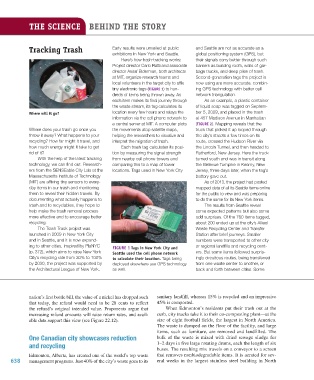Page 639 - Environment: The Science Behind the Stories
P. 639
THE SCIENCE BEHIND THE STORY
Tracking Trash Early results were unveiled at public and Seattle are not as accurate as a
exhibitions in New York and Seattle. global positioning system (GPS), but
Here’s how trash-tracking works: their signals carry better through such
Project director Carlo Ratti and associate barriers as building roofs, walls of gar-
director Assaf Biderman, both architects bage trucks, and deep piles of trash.
at MIT, organize research teams and Second-generation tags the project is
local volunteers in the target city to affix now using are more accurate, combin-
tiny electronic tags (FIGURE 1) to hun- ing GPS technology with better cell
dreds of items being thrown away. As network triangulation.
each item makes its final journey through As an example, a plastic container
the waste stream, its tag calculates its of liquid soap was tagged on Septem-
Where will it go? location every few hours and relays the ber 5, 2009, and placed in the trash
information via the cell phone network to at 457 Madison Avenue in Manhattan
a central server at MIT. A computer plots (FIGURE 2). Mapping reveals that the
Where does your trash go once you the movements atop satellite maps, truck that picked it up looped through
throw it away? What happens to your helping the researchers to visualize and the city’s streets a few times on its
recycling? How far might it travel, and interpret the migration of trash. route, crossed the Hudson River via
how much energy might it take to get Each trash tag calculates its posi- the Lincoln Tunnel, and then headed to
rid of it? tion by measuring the signal strength Rutherford, New Jersey. Here the truck
With the help of the latest tracking from nearby cell phone towers and turned south and was in transit along
technology, we can find out. Research- comparing this to a map of tower the Bellevue Turnpike in Kearny, New
ers from the SENSEable City Lab at the locations. Tags used in New York City Jersey, three days later, when the tag’s
Massachusetts Institute of Technology battery gave out.
(MIT) are affixing tiny sensors to every- As of 2013, the project had posted
day items in our trash and monitoring mapped data of all its Seattle items online
them to reveal their hidden travels. By for the public to view and was preparing
documenting what actually happens to to do the same for its New York items.
trash and to recyclables, they hope to The results from Seattle reveal
help make the trash removal process some expected patterns but also some
more effective and to encourage better odd surprises. Of the 760 items tagged,
recycling. about 200 ended up at the city’s Allied
The Trash Track project was Waste Recycling Center and Transfer
launched in 2009 in New York City Station after brief journeys. Smaller
and in Seattle, and it is now expand- numbers were transported to other city
ing to other cities. Inspired by PlaNYC FIGURE 1 Tags in New York City and or regional landfills and recycling cent-
(p. 372), which aims to raise New York Seattle used the cell phone network ers. But some items followed surpris-
City’s recycling rate from 30% to 100% to calculate their location. Tags being ingly circuitous routes, being transferred
by 2030, the project was supported by deployed elsewhere use GPS technology from one waste center to another, or
the Architectural League of New York. as well. back and forth between cities. Some
nation’s first bottle bill, the value of a nickel has dropped such sanitary landfill, whereas 15% is recycled and an impressive
that today, the refund would need to be 28 cents to reflect 45% is composted.
the refund’s original intended value. Proponents argue that When Edmonton’s residents put their trash out at the
increasing refund amounts will raise return rates, and avail- curb, city trucks take it to their co-composting plant—at the
able data support this view (see Figure 22.12). size of eight football fields, the largest in North America.
The waste is dumped on the floor of the facility, and large
items, such as furniture, are removed and landfilled. The
One Canadian city showcases reduction bulk of the waste is mixed with dried sewage sludge for
and recycling 1–2 days in five large rotating drums, each the length of six
buses. The resulting mix travels on a conveyor to a screen
Edmonton, Alberta, has created one of the world’s top waste that removes nonbiodegradable items. It is aerated for sev-
638 management programs. Just 40% of the city’s waste goes to its eral weeks in the largest stainless steel building in North
M22_WITH7428_05_SE_C22.indd 638 13/12/14 2:25 PM

